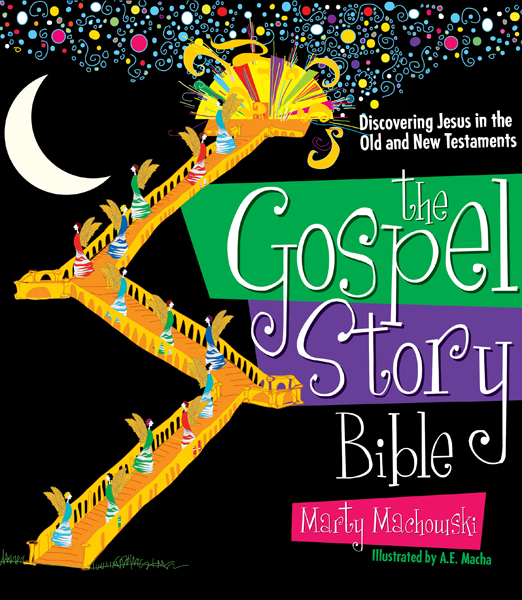The New “Gospel Story Bible”: 67% Off
Last year I wrote the following about Marty Machowski’s Long Story Short: Ten-Minute Devotions to Draw Your Family to God:
This is the best material for family devotions I’ve ever seen. If you’re looking for something careful, creative, and Christ-centered—without being corny, confusing, or condescending—look no further. Pastors would be wise to buy this book by the boxful and get a copy into the hands of each family in their church.”
So I was excited to see that he now has a companion story Bible: The Gospel Story Bible: Discovering Jesus in the Old and New Testaments, which WTS Books is selling at a special rate of $9.99 (regular price is $29.99) for this hardback. The sales lasts for 72 hours. I am glad to recommend it.
You can preview the entire book online for free here.
How does this story Bible compare to the other good and similar books available?
Several thoughts and observations:
(1) It should not go unsaid that we are living in a time of unprecedented gospel-centered resources. We have more available to us than any other generation in the history of the church. To whom much is given, much is required. Praise God for raising up some many gifted teachers to help us equip the next generations! May he keep us faithful.
(2) The last few years have seen a number of especially good story Bibles. If one’s family budget allows it, I think it’s helpful to have more than one. Here’s a brief run-down (in my opinion) of the best of the best:
(a) David Helm’s The Big Picture Story Bible (now also in a read-aloud eBook) is the best in terms of quickly seeing the developing storyline of Scripture, showing how Christ fulfills the pattern of God’s people in God’s place under God’s rule. This is written simply, and it builds anticipation as the kingdom theme unfolds (instead of giving the “Jesus payoff” right away).
(b) Starr Meade’s Mighty Acts of God: A Family Bible Story Book (with a sequel forthcoming) is especially helpful in seeing that God is the main character and the hero of every story. (The Desiring God curriculum does an especially good job at this too.) Sometimes in our desire to be Christocentric we can neglect the theocentric reality of the Word. Discussion questions help to make this a good interactive resource.
(c) This year our family has used The Action Bible more than any other book. It’s a graphic novel of Genesis to Revelation, and this does the best job of telling and showing the details of the biblical stories. The plethora of artwork is realistic and very helpful—especially for short attention spans!
(d) The Jesus Storybook Bible: Every Story Whispers His Name by Sally Lloyd-Jones has been the most popular story Bible on the market in the past few years. It is one of the best for seeing some of the ways that Old Testament characters and events point to Jesus and the need for the gospel. The art is whimsical and Lloyd-Jones writes with literary excellence and a storyteller’s touch. My one qualm is that it so emphasizing the (legitimate) biblical theme of God’s yearning/wooing love that the theme of judgment and wrath in the OT stories tends to be muted; when the story comes to the cross, the readers have not really been “set up” very well to understand the need for propitiation. Despite this, it’s been enormously popular, and deservedly so.
(3) Which brings us back to Machowski’s The Gospel Story Bible: Discovering Jesus in the Old and New Testaments. Here are some things that I like about it:
(a) It contains 156 stories—78 from the OT and 78 the NT.
(b) The retelling is clear and to the point. What it lacks in Lloyd-Jones’s artistry it makes up in accuracy and details.
(c) It includes Bible text in the retellings, and it uses the ESV (which is what our kids memorize from at their school and we use as a family).
(d) The gospel anticipation-application is thoughtful and faithful. As Machowski says in the introduction, “The goal is to thread each of the 156 Bible stories like beads on the silk thread of the gospel, creating one picture with them all.”
(e) The artwork is interesting and well done. They intentionally left the faces uncolored so that children can imagine their own ethnicity as characters in the drama (uncolored in this case means white, though, so I’m not sure kids will pick up on that). I suspect some kids will be drawn more than others to the creative, more abstractish type of art.
(e) There are discussion questions at the end of each story.
(f) This is not a stand-alone project, but goes along with Long Story Short: Ten-Minute Devotions to Draw Your Family to God, and the forthcoming Gospel Story Curriculum (a three-year program being used by over 200 churches).
All of this to say: you cannot go wrong with any of the story Bibles mentioned above; ideally, it’s helpful to use more than one; and I hope many families consider The Gospel Story Bible in particular.

No comments:
Post a Comment